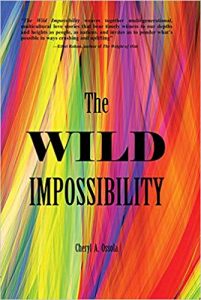THE WILD IMPOSSIBILITY: An Excerpt
Ossola’s novel, The Wild Impossibility (May 2019; Regal House Publishing), has been described as “breathtaking…[a] beautiful page turner” by New York Times bestselling author Katie Crouch, and praised for its “wonderfully rich prose and layered story” by award-winning writer Nina Schuyler. Traveling between modern day Berkeley, CA and a notorious WWII-era Japanese American internment camp, the novel explores the unbreakable bond between mothers and daughters, and the power of family to endure despite distance, time, and long-buried secrets.
We’re delighted to feature this excerpt.
—
 June 16, 1945
June 16, 1945
Maddalena squeezed Regina’s hand as they walked past the Manzanar guardhouse. The day was blistering, hotter than usual for spring, but she didn’t care about the sweat and stink. She was here, finally, in this mysterious place she’d seen only from the back of her father’s car on the road to Independence, or from the back of her horse, riding on Foothill Road. From either direction Manzanar looked the same—flat, repetitive rows of colorless, dismal-looking buildings and dry streets, giving off an air of despair she could smell from a distance.
The camp had been off limits since the day construction began more than three years ago. Her mother’s orders. It was dangerous, Mama said; who knew what the enemy might do? Maddalena had thought about arguing— she’d heard that the camp was going to be home to families, and how dangerous could grandmothers and children be?—but it would have been pointless. Once Mama made up her mind, that was that. Maddalena had kept her word and ventured no farther east than Foothill Road, but that didn’t stop her from wondering what went on in the camp, what those people, supposedly so different from anyone else in Owens Valley, were like. So when Mrs. Henderson poked her head into Regina’s room, where the girls were sitting on the bed playing Hearts that blistering day, and said she was going to an art show at the Manzanar community center and did the girls want to join her, Maddalena jumped up.
“Yes! I mean no,” she said. “I can’t. My mother won’t let me anywhere near Manzanar. She thinks it’s dangerous. She’s afraid of the Japanese.”
“She’s entitled to her opinion, dear, but I think they’re lovely folk.”
“You’ve been there before?”
“I go several times a year,” Mrs. Henderson said. “Their gardens and art shows put the rest of the county to shame. But we must keep peace with your mother. Oh, don’t look so down in the dumps. You’re going, and we’ll make it our little secret.”
Maddalena bounded out of the bedroom and down the stairs before Mrs. Henderson could change her mind.
##
Manzanar buzzed with activity. Men and women who had stopped to chat knotted the streets, while others breezed along, all business. Boys in short pants raced by on important missions, laughing and shouting and tussling with their friends, while teenage girls sauntered in groups or sat on barracks steps, heads together, giggling and gossiping like girls did everywhere. The breeze carried evidence of a baseball game—the distant crack-smack of hide against wood, the hoarse cry of a referee, a smoketrail of cheers. Manzanar seemed vibrant, as full of mainstreet activity as any town in Owens Valley—perfectly normal, Maddalena thought with a shiver, if you ignored the guard towers. Eight of them, where men with guns surveyed the camp.
The girls followed Mrs. Henderson to the auditorium, a cavernous building with a stage at one end and an open space dotted with easels and bulletin boards. The only breath of air came from people moving about; the building sucked in the heat and held onto it, suffocating itself. After twenty minutes of studying watercolor paintings and ink drawings of mountains and flowers, Maddalena thought she’d melt. “Let’s go outside,” she said to Regina. The paintings were pretty, but it was the camp itself that Maddalena wanted to see. After all, she might never get another chance.
“Where?”
“Anywhere. Tell your mother we’ll meet her back here in a little while.”
They walked past row after dismal row of mean-spirited matchstick construction, squat buildings that looked as if a windstorm would send them skyward. No one had designed them, as far as Maddalena could tell; they were too ugly, too cruel, to have been built with anything but disregard and haste. The only beauty came from things the Japanese had created themselves—colorful curtains, flowerpots on the narrow stoops.
“Look,” Regina said, pointing toward a baseball field. “Boys. Lots of them.” She poked Maddalena in the ribs and ran to the bleachers. Maddalena followed, and the girls found seats in the front row, across from left field. Shielding their eyes, they took inventory.
A few of the boys wore baseball caps, but most of them didn’t. How strange to see an entire field of dark-haired boys, when the Lone Pine boys had red hair, or blonde, or a million shades of dirt brown. Most of the Japanese boys wore crew cuts. One boy in left field, with glasses, had hair that was short on the sides but long on top, and he kept tossing a forelock out of his eyes. He should have worn a cap, Maddalena thought.
“This is almost perfect,” Regina said. “All we need is some Coca-Cola and cotton candy.”
“I wish,” Maddalena said. Still, it was a perfect day. No chores, no mother fretting over her, no obnoxious brother making her wish she were an only child. Here she was, on her own with her best friend in this exciting new place. She felt like a tourist in the valley she’d grown up in, seeing things kept hidden from her. And all of it ordinary yet startling.
“I’ll be right back,” she said.
She walked along the edge of the field, taking in the city around her. That’s what it was, a city of more than 10,000, according to her father, bigger than any other in Owens Valley, built for people who didn’t belong there and didn’t want to be there. Looking up at a guard tower, the rounded eye of its searchlight puncturing the brilliant sky, Maddalena shuddered. It was easy to forget what those towers meant when you were outside the barbed wire, doing whatever you pleased. At first, when the plans were being made, then when it was built and the first Japanese came, the camp was all that anyone in Lone Pine and Independence had talked about. No one wanted it, and plenty of people were like her mother, afraid of the strangers who didn’t look like them. Now, three years later, most of the valley residents had lost their fear, and some, like Mrs. Henderson, considered the Japanese people part of their community. Eventually Manzanar blended into the desert valley’s landscape, no more remarkable than the sagebrush and fruit trees born there.
Fifty yards past the ballfield, Maddalena stopped, gazing west. These transplanted people had made Manzanar their home, with art shows, baseball games, and victory gardens. Not the kind of things you’d expect to find in a prison, yet Manzanar was a prison.
From here, inside the fence, Manzanar felt wrong in a way it never had before.
Adapted from The Wild Impossibility by Cheryl A. Ossola. Copyright © 2018. Reprinted with
permission of Regal House Publishing.
—
Cheryl A. Ossola is the author of The Wild Impossibility. A former magazine editor, freelance writer, and editor, her work has been published in Fourteen Hills, Speak and Speak Again, Switchback, Dance Magazine, Dance Studio Life, and San Francisco Ballet’s Backstage and program books. A member of the San Francisco Writers’ Grotto, she now lives and writes in Italy.
https://www.cherylaossola.com/
https://regalhousepublishing.com/product/the-wild-impossibility/
 A neonatal ICU nurse, consumed with grief over the losses of both her mother and newborn daughter, begins to suffer from a series of disturbingly vivid visions. A teenage girl is swept up in a doomed love affair with a young man interned at Manzanar, one of America’s notorious concentration camps for Japanese-Americans during World War II. Though decades—and worlds—apart, the lives of these two women are indelibly intertwined, and the actions of one will have profound and lasting implications on the other.At once a powerful coming-of-age novel, a heartbreaking love story, and a harrowing tale of suspense, The Wild Impossibility masterfully illuminates the resilience of love in the face of tragedy, and the power of family to endure despite distance, time, and heartbreak.
A neonatal ICU nurse, consumed with grief over the losses of both her mother and newborn daughter, begins to suffer from a series of disturbingly vivid visions. A teenage girl is swept up in a doomed love affair with a young man interned at Manzanar, one of America’s notorious concentration camps for Japanese-Americans during World War II. Though decades—and worlds—apart, the lives of these two women are indelibly intertwined, and the actions of one will have profound and lasting implications on the other.At once a powerful coming-of-age novel, a heartbreaking love story, and a harrowing tale of suspense, The Wild Impossibility masterfully illuminates the resilience of love in the face of tragedy, and the power of family to endure despite distance, time, and heartbreak.
Category: On Writing






























